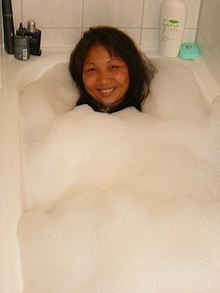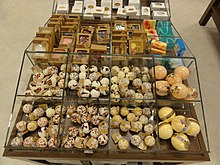foam bath
Foam baths are used to cleanse and refresh the skin. The foam, smell and color of the bath are used for well-being, relaxation and refreshment. Foam baths are mostly liquid and mainly contain detergent surfactants . The foam is mainly used for bathing and degreasing the skin, the care effect is lower compared to oil baths and baths with active ingredients.
application
According to the manufacturer's instructions, the bottle's cap is usually used for portioning. If you want to relax, a bathing water temperature between 36 and 38 ° C is usually chosen. If the bubble bath is used for refreshment, a lower temperature is selected for the bath water (28–34 ° C). If you want a lot of foam to develop, add the bath preparation to the bathtub at the beginning of the water inlet. If you want less foam to develop, add it in the almost full bath.
The bath time should be limited to around 15 minutes, otherwise the skin will be excessively degreased or leached.
Oxygen-saturated baths - bubbles in the water
Bubbles in the water are created either through mechanical aeration or with solids that produce gas. For mechanical aeration, nozzles are used in some cases to whirl the water, with devices provided for this purpose either permanently or temporarily installed in the bathtub or pool, called whirlpools . The solids can be small granules or so-called bath bombs (also known as "bathfizzies"). They produce carbon dioxide when a carbonate or bicarbonate reacts with an organic acid.
It is possible to produce baths that (as in beer) bubble and carry foam at the same time, but the combination has not caught on. Mechanical aeration would produce too much foam in a bubble bath - the internet is full of firsthand stories and photos of such experiences - and many hot tubs are rented so they will not drain between uses and should be kept free of materials that do not belong in. In hot tubs for removing tissue from the body of burn victims, anti-smoking agents are typically added to counteract the film-forming process that some medicinal additives have as a side effect, but it is sometimes reduced or omitted for children to provide the pleasant distraction to facilitate wound care. Bathfizzies that also foam tend to produce disappointingly little foam if left to hiss, and the aeration of the water takes away any gas.
Bubbles on the water
Bubble bath is created by adding products that contain surface-active substances to water, and by temporary aeration (by moving the water, usually only with a tap, from which water runs into the basin). This practice is very popular because the foam isolates the bath water and thus keeps it warm longer. In addition, the foam (as a reduced lime soap - solvent ) depositions on the tub and below the water surface (→ water hardness ), which can result from soap and mineral-containing water. The foam can hide the body of the bather, which looks more moral, or in the theater or in films it can give the impression that an actor is bathing normally even though he is actually wearing something. The bubble bath is particularly popular with children, it motivates them to take a bath.
In the German language, the term foam bath is more commonly used for foam on the water.
Bath additives for this purpose are called bath foam or bubble bath and often contain substances that serve additional purposes (e.g. refreshment, relaxation). The bath additives are available in liquid form as well as in dry, compressed form (e.g. bath balls, bath hearts). In much higher concentrations (for example on a washcloth) the substances can also be used to wash skin and hair (especially in liquid form), therefore they are sometimes marketed for different uses; in a few cases also as budget funds such as B. as a mild detergent for hand washing or to avoid limescale deposits on the bathtub (foaming or non-foaming).
history
In earlier times the body was cleaned in streams and lakes. Large bath houses, thermal baths, were built by the Greeks and Romans. Bathtubs have been used for a long time. However, it was only with the spread - since 1960 - of synthetic surfactants that foam production and the use of fragrances and dyes in bath water became possible.
Foaming bath products became popular as foaming bath salts in the early 20th century; the "bath bomb" only late in this century. The earliest bubble baths were lathered with soap, a practice that became common shortly after the soap flakes were marketed. Also saponins were used for foaming of oxygenated (bubbling) bubble bath. Later on, bubble baths containing surfactants became more popular; an early published product with alkyl sulfate was used in the original production of the play " The Women " in 1936 , although it is possible that a similar mixture has been used to produce bath foam in photos since the Dreft company in 1933. After products were mass-marketed in supermarkets around the 1960s, bubble baths became the standard way of bathing children. The “Bub” brand was marketed in the USA, the “Matey” brand in Great Britain and “ Badedas ” in Germany since shortly before 1960.
Machine-operated bubbling baths emerged for therapeutic use in the early 20th century, but became more widely used with the advent of the jacuzzi . The trends mixed when the group whirlpool , which originally heated still water ( hot tub ), became more popular than a communal whirlpool bath. In the late 20th century, jet powered hot tubs for home use had become very popular.
literature
- Wilfried Umbach: Cosmetics, development, manufacture and use of cosmetic products . 2nd Edition. Georg Thieme Verlag, 1995, ISBN 3-13-712602-9 , p. 115
Individual evidence
- ^ Wilfried Umbach: Cosmetics . 2nd Edition. Georg Thieme Verlag, 1995, p. 114

